Enrollment in Judaic studies courses reached 199 students last year, compared with 160 students in the 2013-14 academic year and 280 students in the 2007-08 academic year., continuing a decade-long trend of fluctuation.
The department currently has three concentrators, said Adam Teller, associate professor of history and Judaic studies. In 2013 there was one, in 2014 there were two and in 2015 there were none, according to Focal Point.
“What we try to do is take students who are doing another concentration and have an interest in these matters and help them do a second concentration” in Judaic studies, Teller said. Most students who enroll in a Judaic studies course do not concentrate.
The Department of Judaic Studies is offering 11 courses this semester, some with miniscule enrollments. Only one student is enrolled in JUDS 0681: “Great Jewish Books;” JUDS 1701: “Jews and Revolutions in the 20th Century” has an enrollment of three.
The optimal class size is “somewhere in the range of 12,” said Michael Satlow, professor of Judaic studies. The overall decline in enrollment in Jewish studies at Brown — 7 percent since 2005 — corresponds with a downward trend observed at peer institutions across the country.
In a survey conducted this year by the Association for Jewish Studies, 30 percent of the 1,790 professors surveyed reported a perceived decline in enrollment, whereas only 21 percent reported a perceived increase.
Professor of Judaic Studies David Jacobson cited declining interest in the humanities as a possible reason for the current trend in Judaic studies.
Most attribute this to students’ deciding to “undertake a course of study that would lead more directly to success in a career that will provide them with economic security,” Jacobson wrote in an email to The Herald.
Satlow echoed this sentiment, saying the 2008 recession may have influenced students to take more career-focused classes. Most of the top-10 declared concentrations are “what you might call practical concentrations,” he said, adding that students may “think that this is going to be a path toward future employment.”
Teller identified a different reason for the decline in Judaic studies enrollment, citing a millennial desire to effect immediate change on global issues rather than study the history behind them first. Millennials “see the problems in the world around them as very, very important and to be dealt with now,” he said.
The Judaic studies department has developed new courses in an attempt to combat low enrollment. Out of the 24 courses offered by the department this year, six are new or have been redesigned, Teller said. Among the new courses for this year are “Jews and Revolutions in the 20th Century,” taught by Visiting Associate Professor of Judaic Studies Rachel Rojanski, and JUDS 0060: “The Bible and Moral Debate,” taught by Professor of Judaic Studies and Religioius Studies Saul Olyan.
The curriculum overhaul represents an effort to make the program more interdisciplinary, Satlow said. “To me, the draw of Judaic studies, intellectually, has always been its interdisciplinarity,” he said. A Judaic studies course “really approaches a problem from a variety of disciplinary perspectives, and that can be intellectually freeing.”
Students enrolled in Judaic studies courses voiced positive feedback on the curriculum reform efforts.
“There are a lot of opinions on campus regarding pro-Israel and anti-Israel. I think it’s really important that we become informed from an academic perspective, and I think that is a practical skill, being able to discuss” prominent political issues, said Shira Buchsbaum ’19, a Herald contributing writer, who is taking JUDS 0050M: “Difficult Relations? Judaism and Christianity from the Middle Ages until the Present,” a first-year seminar taught by Teller.
Julia Rosenfeld ’19 said after “randomly” shopping a Judaic studies course that piqued her interest, she hopes to take more classes in the department.
Another reason for decline in enrollment could be a drop in students who identify as Jewish, since Jewish students may be inclined to take courses related to their religion, Jacobson wrote.
The percentage of students who indicate no religious preference on an annual survey distributed by the Higher Education Research Institute at University of California at Los Angeles increased about 12 percent from 2005 to 2015.
In response to the decline in religious identification, the Judaic studies department is making efforts to recruit more non-Jewish students.
But the department seeks to attract all students, regardless of religious identity, Teller said. “We’re aimed to anyone who’s interested,” he said.
One problem that the Judaic studies department faces when attempting to recruit students is a misperception that Judaic studies classes require a prior knowledge of Judaism or Hebrew, Teller said. In reality, almost none of the courses in the department require a background in Judaic studies, he said.
“We’re not an extension of religious school, of synagogue, of Hillel, or anything like that,” Olyan said. “My biggest concern is that some students out there do perceive us that way.”





